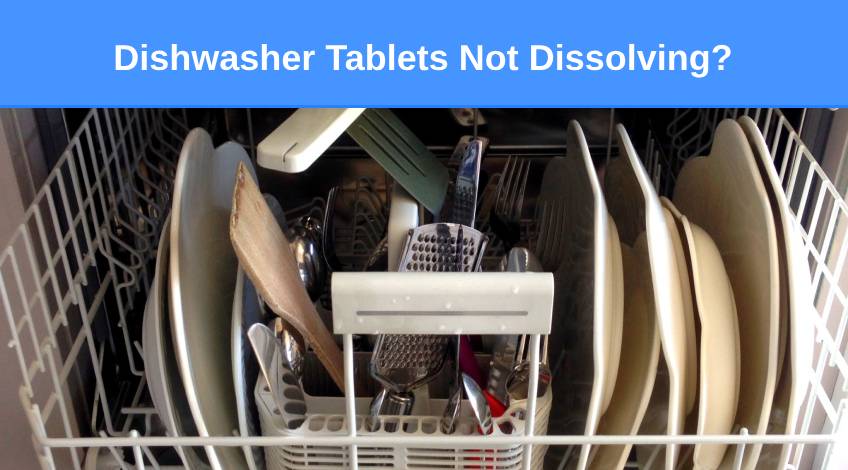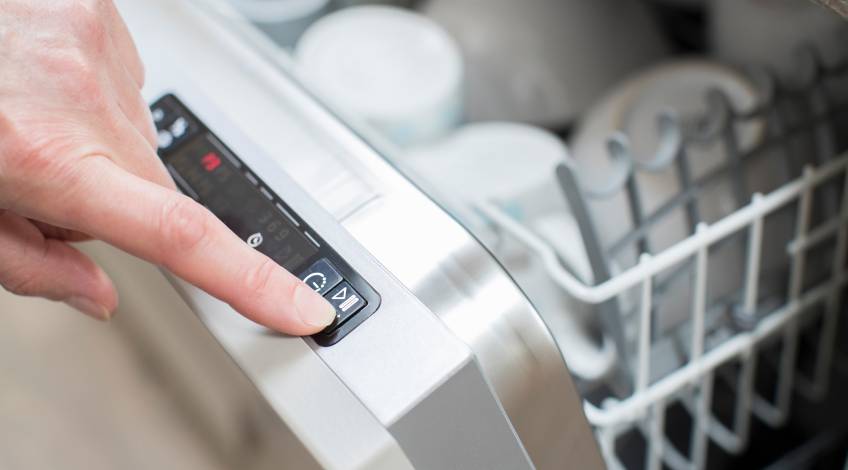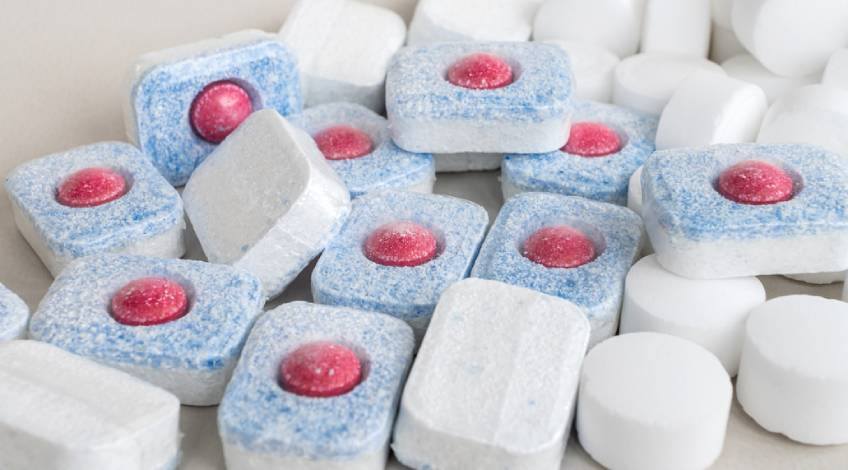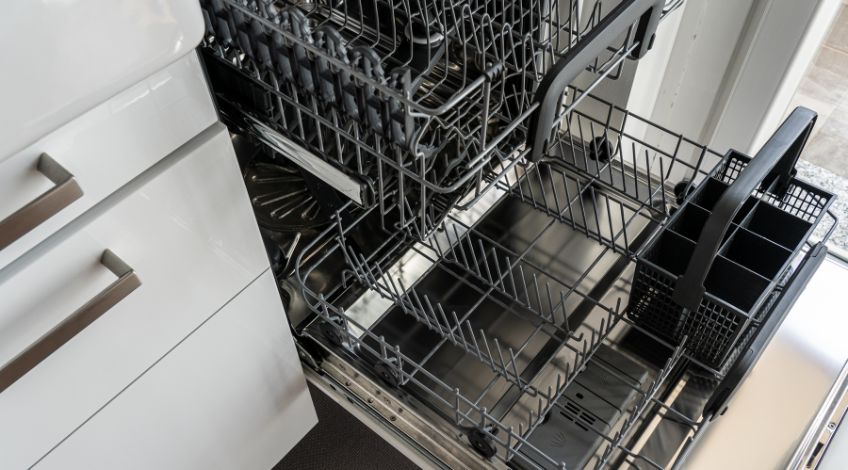
Dishwasher Tablets Not Dissolving? (here’s why & what to do)
The dishwasher is one of the greatest and yet often ignored kitchen appliances. It’s great because it takes all of the work out of washing and drying your dishes and ignored because once loaded, well, it just gets on with it.
In many cases, it’s only when there’s some sort of a problem that we actually give the dishwasher any thought at all. One of the more common issues reported with dishwashers is that the dishwasher tablets are not dissolving.
This leaves a residue on the dishes making them look and feel dirty. If this is the problem you’re experiencing, keep reading. In this article, we look at the reasons why the dishwasher tablets aren’t dissolving and offer ways to solve these problems.
How Do Dishwashers Work?

Before we look into the possible reasons why the dishwasher tablets fail to dissolve, it’s important to understand exactly how a dishwasher gets the dishes clean.
Once the racks have been correctly loaded and the dishwasher tablet has been placed in the detergent dispenser. We select the wash cycle we want and press the start button ensuring that the door of the appliance is firmly closed.
The dishwasher takes water in via the water inlet valve which is then sprayed over the dishes to loosen any stuck on food using the spray arms. Once the dishes are sufficiently moistened, the tub of the dishwasher fills at the bottom with water.
It’s at this point that the detergent dispenser opens allowing the dishwasher tablet to fall onto the floor of the dishwasher where it is dissolved in the hot water. This detergent filled water is then sucked into the drain at the bottom of the tub and then pumped up through the spray arms which rotate to ensure every dish gets washed.
Once the wash cycle has completed, the soapy, dirty water is drained away through the drain hose and the dishwasher uses fresh water to rinse the dishes. Once the dishes are fully rinsed, the drying cycle initiates to ensure the now clean dishes are dried and ready to pack away in the cupboard once the dishwasher cycle has finished.
Now we know what the dishwasher is designed to do and what’s supposed to happen, we can move on to the reasons the dishwasher tablet might fail to dissolve.
Why Are The Dishwasher Tablets Not Dissolving?
There are several reasons why the dishwasher tablet might not dissolve with many being relatively easy to solve. They include;
| Possible Cause | Solution |
|---|---|
| Short Wash Cycle Selected | Choose a wash cycle long enough to dissolve the tablet |
| Water Temperature Too Low | Select a wash cycle hot enough to dissolve the tablet |
| Damp Dispenser Drawer | Ensure the dispenser drawer is dry before adding tablet |
| Damp Tablet | Never use damp tablets and store tablets in a dry place |
| Dispenser Drawer Blocked | Ensure dishes are stacked correctly and not blocking the dispenser drawer |
| Damaged Or Defective Detergent Dispenser | Inspect, repair or replace the dispenser drawer as necessary |
| Wrong Type Of Detergent Used | Consult your user manual for the correct type of detergent |
| Impeded Or Defective Spray Arms | Ensure the spray arms work properly and are not blocked or clogged |
| Defective Water Inlet Valve | Inspect, repair or replace the water inlet valve as necessary |
| Low Water Pressure | Check inlet hose for twists, contact water authority if water pressure proves to be too low |
Short Wash Cycle Selected
Some short wash cycles are not long enough to allow the dishwasher tablet to fully dissolve before the rinse cycle begins. Try running a longer cycle to give the detergent more time to dissolve.
Water Temperature Too Low
If the water temperature is too low it could prevent the dishwasher tablet from dissolving properly. Try selecting a hotter cycle and see if that solves the problem.
You should also check whether the dishes feel hot as soon as the cycle finishes. If the dishes feel cold and the tablet still isn’t dissolving fully, it’s time to contact a technician or the manufacturer if the appliance is still under warranty.
Damp Dispenser Drawer
You should only place dishwasher tablets into the detergent dispenser if it is dry. If the dispenser drawer is damp, parts of the tablet could stick to the dispenser and clog it.
If you find the dispenser drawer is often damp, try placing the dishwasher tablet directly onto the floor of the tub. This isn’t ideal, but it ends up there after the initial wetting of the dishes anyway and won’t cause any major problems.
Damp Tablet

You should always keep dishwasher tablets in an airtight container away from any source of moisture. Otherwise they may become damp and unable to perform as they are intended to.
If you load the dishwasher hours before using it and add the tablet at the same time, it can become damp in the interim period. One of the best ways to prevent the dishwasher tablet from becoming damp is to only place it in the dispenser drawer immediately prior to using the dishwasher.
Dispenser Drawer Blocked
If the dishes haven’t been stacked in the racks properly, it’s possible for a pan handle or piece of crockery/utensil to prevent the dispenser drawer from opening fully or at all.
This would prevent the tablet from falling to the base of the tub and subsequently stop it from dissolving.
Always ensure that your dishes, pots etc, are stacked correctly to allow the free opening of the detergent drawer and the subsequent dissolving of the tablet.
Damaged Or Defective Detergent Dispenser
If the dispenser is damaged or has developed a fault, it’s possible that the detergent isn’t being released at the right time. You should check the latch for any signs of wear or damage and check that it opens at the right time in the cycle.
This can be achieved by opening the dishwasher door a few minutes after the cycle has started. If the detergent door is not open or only partially open, you will need to get it looked at by a technician.
Wrong Type Of Detergent
If the appliance appears to be running as it should, the problem could be that you’re using the wrong type of detergent. Due to differences in the design of certain dishwashers, some are only compatible with certain types or brands of detergent.
This could be what’s causing the problem in your dishwasher. It could be that your appliance wasn’t designed for dishwasher tablets at all. It might work better with powdered dishwasher detergent or even dishwasher gel pouches.
For instance, Bosch recommends using Finish dishwasher tablets in their dishwashers. Consult your user manual or contact the manufacturer for more information.
Impeded Or Defective Spray Arms
As we saw earlier, the dishes get cleaned as the spray arms rotate and spray water mixed with detergent to wash them. The spray arms then spray clean water to rinse the now washed dishes.
If the spray arms have been impeded by an out of place dish, pot or utensil, they cannot rotate or spray properly. This will prevent the water from becoming distributed as it should be.
You should also check the nozzles on the spray arms for any blockages (this is a particular problem if you live in a hard water area). You will need to remove the spray arms from the dishwasher and inspect the nozzles.
If you see any blockages, they should be removed using a wooden toothpick. Be sure to prise the blockage out of the nozzle and not force it in any tighter.
If there is limescale stuck in the nozzles, you can soften it by soaking the spray arms in a white vinegar and warm water solution (50/50 mix) for 15 to 30 minutes before attempting to remove the blockages.
Defective Water Inlet Valve
If the dishwasher isn’t receiving sufficient water to dissolve the dishwasher tablets, it could be due to a defective water inlet valve. All of the water that is supplied to your dishwasher enters via the water inlet valve.
Over time, these valves can become damaged, clogged or start to leak. All of which will affect the flow rate of water into the dishwasher. You can inspect the inlet valve visually yourself after removing some of the panelling on the appliance.
If it appears to be damaged, defective or leaking, it will need to be replaced. This is a job that can be done by an enthusiastic DIYer, or left to a professional if you don’t feel confident in your abilities or your appliance is still under warranty.
Low Water Pressure
If the dishwasher doesn’t get enough water, it cannot dissolve the tablet. This could be caused by low water pressure. The first thing to check is whether the inlet hose is twisted, kinked or damaged in any way.
If the inlet hose looks fine, you’ll need to check the water pressure in your home. Dishwashers need a water pressure of between 20 to 120 psi (pounds per square inch).
You can check your home’s water pressure by filling a 1 gallon (4.5 litre) bucket with cold water from your kitchen tap. If it takes 30 seconds or less to fill, the water pressure entering your home is adequate.
If the bucket takes longer than 30 seconds to fill, your water pressure is inadequate. You will need to contact your local water authority about this.
Defective Water Pump
The pump moves the water around the dishwasher drawing it up from the tub floor and distributing it through the spray arms. If the pump develops a fault or becomes defective, it can prevent enough water from pooling at the bottom of the tub to dissolve the tablet.
We recommend getting a technician to investigate and fix this issue for you. If your appliance is still under warranty, contact the manufacturer and get them to investigate.
Ways To Ensure Your Dishwasher Runs Properly

Dishwashers like all other appliances are designed to run at their optimum best to give you the best results possible. However, they require help in the form of maintenance. For your dishwasher to run at its best you need to;
- Run A Hot Service Wash At Least Once A Month
You should run the empty dishwasher on the hottest cycle using a commercial dishwasher cleaner as per the instructions on the packaging or a bowl of white vinegar placed on the top rack at least once per month to ensure the smooth running of your appliance. - Clean The Filter Monthly
The filter in your dishwasher is likely to become clogged over time which can cause all manner of problems. To prevent this, you should remove the filter and wash it every month. Any stubborn stains can be removed by soaking in either warm soapy water or a white vinegar/warm water solution (50/50 mix) and scrubbing gently using a toothbrush. - Clean The Door Seal (Gasket) Monthly
Wipe around the door seal with a damp cloth to remove any dirt or detergent residue. If there is any evidence of mould, treat with white vinegar before rinsing with clean water. - Clean The Dispenser Drawer Regularly
Regularly check the dispenser drawer for any detergent residue and wash away using a damp cloth. Remember to dry the dispenser thoroughly before placing a dishwasher tablet in the dispenser. - Check The Inlet & Drain Hoses Regularly
Inspect the inlet hose and drainage hose regularly to ensure they are not twisted or kinked. This will prevent problems with drainage and should help the dishwasher tablets to dissolve properly.
SEE ALSO: What Are The Best Dishwasher Tablets?
Frequently Asked Questions
If the tablet keeps sticking to the dishwasher it could be due to the dispenser door being blocked by pots, pans or utensils, the tablet is damp, the dispenser drawer is damp or you are using the wrong type of detergent.
If your dishwasher is leaving tablet residue it is probably because; the cycle selected isn’t long enough or not hot enough, the water pressure is too low, the detergent dispenser is clogged or defective or you’re using the wrong detergent type.
It’s not advisable to put a dishwasher tablet in the bottom of the dishwasher because it has the potential to be rinsed away before it has had a chance to work. The dispenser drawer opens at the right time in the cycle for the tablet to work properly. Placing the tablet on the bottom of the dishwasher before the cycle commences is too soon.
Also, follow us on Pinterest ...



